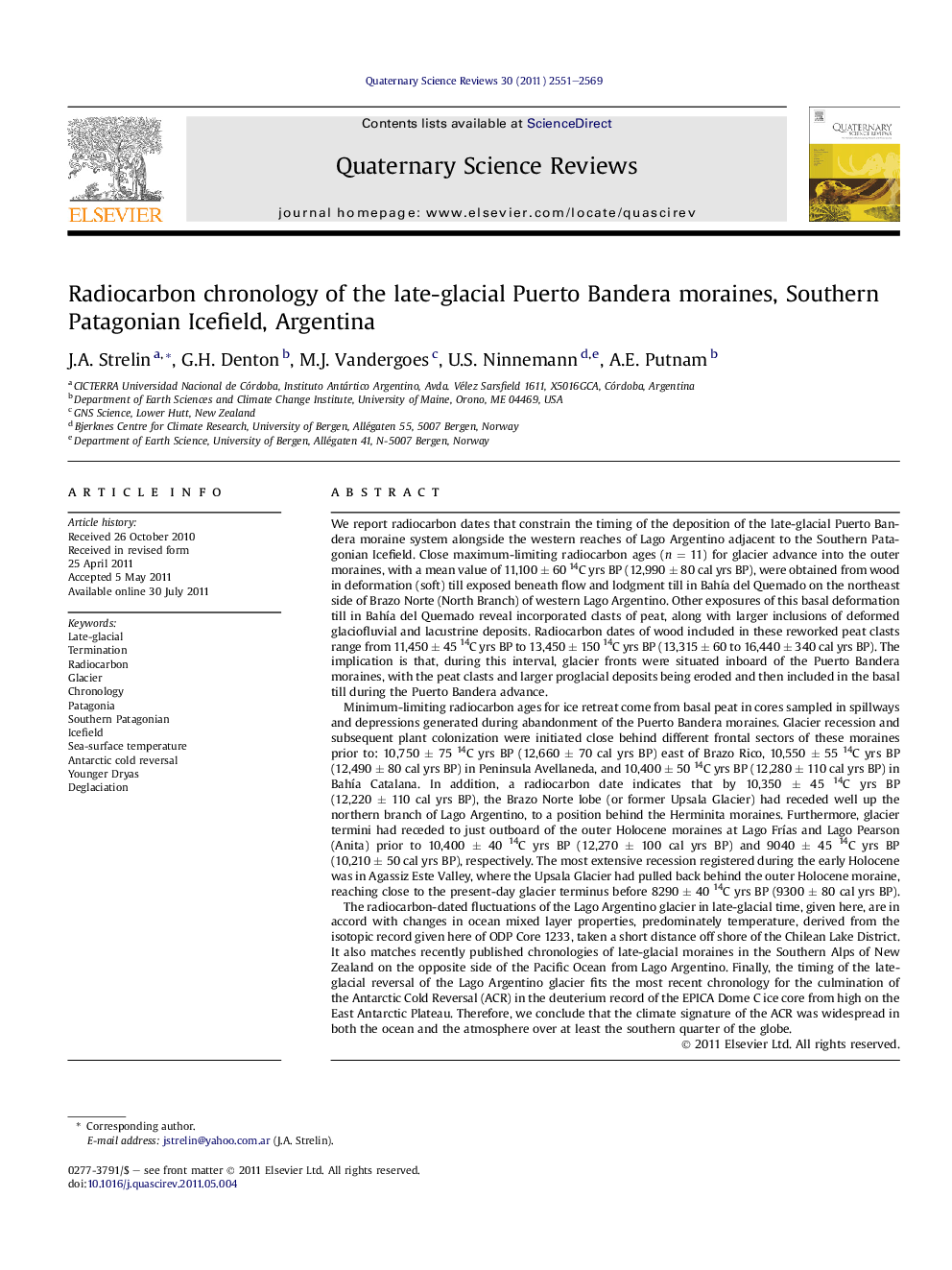| کد مقاله | کد نشریه | سال انتشار | مقاله انگلیسی | نسخه تمام متن |
|---|---|---|---|---|
| 4736716 | 1640908 | 2011 | 19 صفحه PDF | دانلود رایگان |

We report radiocarbon dates that constrain the timing of the deposition of the late-glacial Puerto Bandera moraine system alongside the western reaches of Lago Argentino adjacent to the Southern Patagonian Icefield. Close maximum-limiting radiocarbon ages (n = 11) for glacier advance into the outer moraines, with a mean value of 11,100 ± 60 14C yrs BP (12,990 ± 80 cal yrs BP), were obtained from wood in deformation (soft) till exposed beneath flow and lodgment till in Bahía del Quemado on the northeast side of Brazo Norte (North Branch) of western Lago Argentino. Other exposures of this basal deformation till in Bahía del Quemado reveal incorporated clasts of peat, along with larger inclusions of deformed glaciofluvial and lacustrine deposits. Radiocarbon dates of wood included in these reworked peat clasts range from 11,450 ± 45 14C yrs BP to 13,450 ± 150 14C yrs BP (13,315 ± 60 to 16,440 ± 340 cal yrs BP). The implication is that, during this interval, glacier fronts were situated inboard of the Puerto Bandera moraines, with the peat clasts and larger proglacial deposits being eroded and then included in the basal till during the Puerto Bandera advance.Minimum-limiting radiocarbon ages for ice retreat come from basal peat in cores sampled in spillways and depressions generated during abandonment of the Puerto Bandera moraines. Glacier recession and subsequent plant colonization were initiated close behind different frontal sectors of these moraines prior to: 10,750 ± 75 14C yrs BP (12,660 ± 70 cal yrs BP) east of Brazo Rico, 10,550 ± 55 14C yrs BP (12,490 ± 80 cal yrs BP) in Peninsula Avellaneda, and 10,400 ± 50 14C yrs BP (12,280 ± 110 cal yrs BP) in Bahía Catalana. In addition, a radiocarbon date indicates that by 10,350 ± 45 14C yrs BP (12,220 ± 110 cal yrs BP), the Brazo Norte lobe (or former Upsala Glacier) had receded well up the northern branch of Lago Argentino, to a position behind the Herminita moraines. Furthermore, glacier termini had receded to just outboard of the outer Holocene moraines at Lago Frías and Lago Pearson (Anita) prior to 10,400 ± 40 14C yrs BP (12,270 ± 100 cal yrs BP) and 9040 ± 45 14C yrs BP (10,210 ± 50 cal yrs BP), respectively. The most extensive recession registered during the early Holocene was in Agassiz Este Valley, where the Upsala Glacier had pulled back behind the outer Holocene moraine, reaching close to the present-day glacier terminus before 8290 ± 40 14C yrs BP (9300 ± 80 cal yrs BP).The radiocarbon-dated fluctuations of the Lago Argentino glacier in late-glacial time, given here, are in accord with changes in ocean mixed layer properties, predominately temperature, derived from the isotopic record given here of ODP Core 1233, taken a short distance off shore of the Chilean Lake District. It also matches recently published chronologies of late-glacial moraines in the Southern Alps of New Zealand on the opposite side of the Pacific Ocean from Lago Argentino. Finally, the timing of the late-glacial reversal of the Lago Argentino glacier fits the most recent chronology for the culmination of the Antarctic Cold Reversal (ACR) in the deuterium record of the EPICA Dome C ice core from high on the East Antarctic Plateau. Therefore, we conclude that the climate signature of the ACR was widespread in both the ocean and the atmosphere over at least the southern quarter of the globe.
► We present a radiocarbon chronology of late-glacial glacier behavior in Patagonia.
► Glacier advance occurred ∼13,000 yrs ago.
► Ice receded to near-present-day margins by ∼12,000 yrs ago.
► South Patagonian glaciers registered Antarctic Cold Reversal.
Journal: Quaternary Science Reviews - Volume 30, Issues 19–20, September 2011, Pages 2551–2569